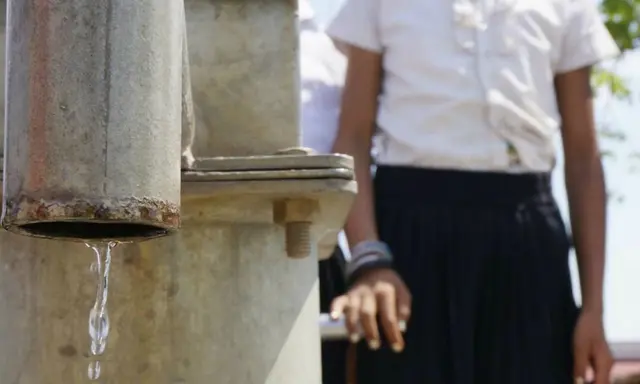Absenteeism from classes is also on the rise as some parents force children to collect water for the family from distant sources
In Cambodia, riverbeds are dry and cracked and the wind feels like a gust from an oven. An extreme heatwave has followed a poor rainy season drying wells, killing cattle and causing water shortages.
Schoolchildren have been hit hard. Many schools have no drinking water, and no sanitation. The ponds and reservoirs that remain are turning into boiling, algae-ridden swamps and poor families are having to pay for bottled water. Where children suffer from poor nutrition the shortage is making things worse.
“Children are often the most vulnerable in situations of water shortages,” said Iman Morooka, Chief of Communication for Unicef Cambodia.
“Undernutrition among children is already prominent in Cambodia: 32 per cent of children under-5 are stunted, 24 per cent underweight, and 10 per cent have acute malnutrition.”
A record-breaking high of 42.6°C was recorded in Preah Vihear Province on April 15, according to data collected by independent meteorologist, Maximiliano Herrera.
Two schoolchildren look out over parched farmland in Kampong Chhnang province, just north of Phnom Penh. Photo: SCMP
“Day after day, the heat wave has been an endless surprise after surprise,” he said.
“Temperature records are falling like stones.”
Cambodia has been affected by a region-wide heatwave that has broken records in Thailand, Laos and Singapore.
It has been caused by the El Nino weather cycle, a warming of sea-surface temperatures in the Pacific that has been tied to crop damage, fires and flash floods
“El Nino has potentially dramatic effects (causing) extreme weather (like) drought, floods and heat waves,” Herrara said.
Last month, Malaysia had to close 250 schools when water reserves dropped below the “danger mark,” according to a report in Asia Correspondent. Vietnam and Thailand predict a bad rice crop this year spreading food insecurity in the Philippines and Indonesia, which import millions of tonnes of the staple.
Cambodian men use a net to catch fish in a drying pond in a village in Kandal province. Photo: AFP
Animals have suffered too, with freshwater fish dying in Malaysia and elephants perishing in Vietnam. Nine orangutans died in Indonesian Borneo after a fire engulfed a parched forest.
In Cambodia, over a third of schools have been impacted and 50 per cent of children are lacking sufficient water, according to Cha Sophea, Director of Primary Education at the Ministry of Education.
Absenteeism is on the rise, while the Ministry of Education had no statistics available, on the ground the situation is clear.
“30-40 per cent of my children haven’t come to school,” said Pim Bun Leap a school principal from Tboung Khmum Province.
“Because it’s too hot and sometimes their parents keep them home so they can help bring water from distant sources.”
As the wells dry up, rural families (who account for 80 per cent of the population, according to the World Bank) must travel further to water or pay for a delivery.
Cambodian Prime Minister Hun Sen helps hand out large bottles of water to villagers in northwestern Banteay Meanchey province. Photo: Xinhua
In Tboung Khmum, it costs 5000 Riel (US$1.25) for enough water to last three or four days. Families must also pay 500 Riel per child for bottled water at the local school. For those with two or more children, the extra expense is taking up 25 per cent of their $5 per day income.
In Kampong Chhang Province, the stream that feeds a local dam has dried up leaving the water stagnant and disease-ridden. No-one drinks from it anymore because of the risk of diarrhoea, fever and malaria. They don’t even want their animals drinking it.
“Five cows died after drinking the water here,” said Hun Heng, director of the school support committee.
“(And) when the children wash with that water they get itchy and irritated skin.”
Several algae blooms float on the water’s surface.
“If there was a flow of water it would prevent some of the organisms proliferating,” said Abigail Beeson, a health and nutrition specialist at Save the Children.
Back in Tboung Khmum, children raise their hands when asked about the water crisis. Close to 70 per cent now pay for bottled water or, if they can’t afford to, they ask their friends for a share. The rest bring water from home.
“It’s difficult to get water because some of the wells have dried up,” said Srey Norn, a 13 year-old girl. “My siblings and I have to go to wells very far away and carry the water home.”
There is a water purifier in the classroom but it’s covered in dust. The teacher, Hen Soha said they have not used it since February.
“Since it’s been hot the water has become (contaminated) with debris. Now even the purifier can’t clean it.”
In response to the crisis, the Cambodian government has cut the school day by an hour during the hottest parts of the day.
“I’m worried we won’t be able to finish the curriculum,” Soha said. “We’re getting behind schedule.”
“I know it’s difficult,” said Sophea.
“We suggest the teachers keep the core subjects of Maths and Khmer and reduce the content of (non-core) lessons such as social studies.”
Sophea and Nath Bunroeun, Secretary of State for Education, are currently touring the country to assess the situation. They are recommending provincial authorities buy-in water for affected communities.
The problem is under control, they said.
“Some schools have no problem,” Sophea said. “But if no rains come next month even more schools will lack water.”
(SOUTH CHINA MORNING POST)
 简体中文
简体中文

